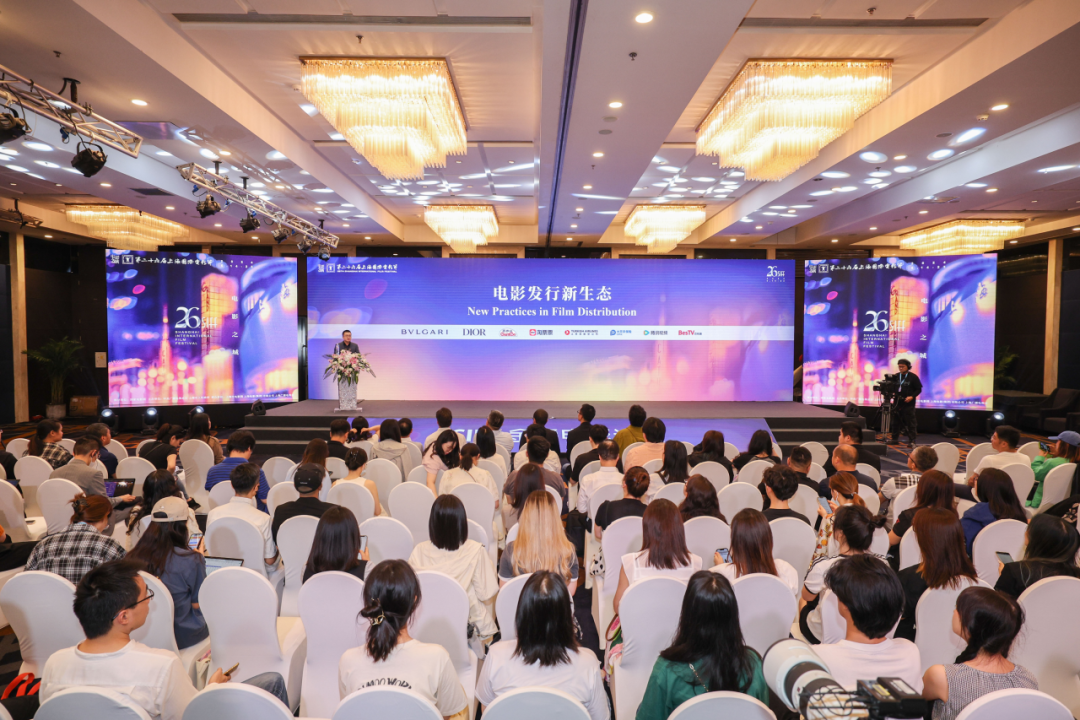SIFFORUM | To Cultivate a New Ecology of Film Distribution
Facing the current phenomenon of crowded film market schedules and inadequate content supply, achieving normalized supply of diverse high-quality films is crucial for the high-quality development of China’s film industry. On June 17, at the 26th Shanghai International Film Festival, the “New Practices in Film Distribution” forum explored through the analysis of domestic and international distribution trends how to implement differentiated distribution mechanisms such as “segmentation, targeting, and regionalization”. This aims to meet diverse entertainment and aesthetic demands of audiences, envisioning a refined, diversified, and market-oriented new ecosystem of film distribution.

During the forum, Jia Zhangke, newly elected president of the China Film Directors’ Guild, emphasized in his speech that the Chinese film industry needs a more diversified and internationalized supply of high-quality content to activate the vast underutilized market resources and empower the global influence of the Chinese film industry.
Professor Zhi Feina from the Chinese National Academy of Arts, Qi Hai, Vice President of Guangdong Motion Picture Industry Association, Supervisor of Planning of Guangzhou Qinggong Cinema, and Boris Puguet, Partner at international film distribution company Heylight, delivered keynote speeches.


Jia Zhangke
Director, Screenwriter, Producer
In the realm of differentiated distribution mechanisms, the pivotal query remains, “Where do films originate?” On the creative front, it begins with domestic cinema diversifying to produce more market-oriented genres. On the distribution end, there’s a pressing need to expand the importation of international films. Imagine if China’s over 80,000 screens could annually accommodate over a thousand films, with half being international; then, China’s market influence would naturally manifest. This would profoundly shape the entire film industry ecosystem, drawing global talent and outstanding works towards the Chinese market. Conversely, a decline in international screenings could lead to global market marginalization. Hence, fostering an open, influential Chinese cinematic image is key to asserting leadership in the global cultural marketplace.

Boris Puguet
Partner at international film distribution company Heylight
A few days back, we held a preview in France for CREATION OF THE GODS: KINGDOM OF STORMS, our latest film venture. Initially, we expected the audience to be mostly Chinese, but to our surprise, 60% were French. This summer, we’re set to release this film across 400 theaters - a testament to our most successful collaboration with Chinese cinema yet. We firmly believe that Chinese blockbuster films can rival American counterparts. In the French market this year, American blockbusters have decreased by 50% since the Hollywood strike two years ago. Moreover, we’ve noted that French audiences are a bit weary of American mega-hits like Marvel films; they crave something distinctly different in the blockbuster arena. Hence, through this work, we’re sending a message to French viewers: that Chinese blockbuster quality is stellar and refreshingly innovative.

Qi Hai
Vice President of Guangdong Motion Picture Industry Association, Supervisor of Planning of Guangzhou Qinggong Cinema
Let's not just dwell on current challenges; let’s also recognize the conveniences brought by the new media era to film distribution and screening. Given the will, film marketers can devise ingenious strategies. For differentiated distribution, we need sustainable incentive mechanisms to motivate distribution and exhibition personnel, harnessing their enthusiasm and intelligence. When they receive recognition, better treatment, and societal respect, their drive intensifies, fostering a blossoming of creative ideas. They’ll conceive solutions far superior to mine, paving a way for films in the market and providing opportunities for creators. This is why I strongly advocate for establishing vital incentives for distribution and exhibition personnel.

Takeuchi Ryo
Documentary Director
In Japan, there are only four to five hundred cinemas. I can reach out to every single theater owner, and if they like what they see, they’ll screen it. What’s crucial is my nationwide roadshow across Japan, where I discovered each cinema is unique - different décor, different movie selections. Some specialize in documentaries, others in Asian films, each with its own fan base. There’s no need for special promotion; many viewers don’t know our work beforehand; they simply love the theater’s selections. This is something Chinese cinemas could learn from - cultivating their own fans who visit as if it’s an amusement park, eager to see whatever the theater’s curator has chosen.

Wu Feiyue
Founder of Elephant Pictures
In the past, we often described the entire industry chain - production, promotion, distribution, and screening - as a 4×100 meter relay race, where the film is handed off to the next party, seemingly disconnected from the previous one. Later, I realized this analogy is incorrect. Our relationship with the audience is more like a tug-of-war, with the production, promotion, distribution, and screening teams pulling together on one side against the audience on the other. For commercial blockbusters, we are up against a massive force, so we exert all our effort to pull them over. But for a documentary or an art film, the opposing force might only be a few thousand or tens of thousands of people. Do we still try? If we dismiss these smaller audiences today, we may find them out of reach tomorrow. Chinese cinema will permanently lose this segment of the audience. This issue is now very urgent. We must abandon the mindset of rough operations and collaboratively, across all industry chain segments, strive for refined, segmented operations to attract and serve these audiences well. This is our shared future.

Zhi Feina
Professor from the Chinese National Academy of Art
Today, I would like to discuss the principles of innovation beyond tradition in film distribution from a broad perspective. Firstly, my overall assessment of the current market is that it is characterized by intense and undifferentiated competition, whereas what we aspire to is refined and differentiated competition. Secondly, we are about to enter an era of refined and personalized consumption. The industry has laid a very good market foundation for us, but there is still significant room for growth and optimization. Thirdly, we must adhere to exploring the development path of Chinese cinema with socialist characteristics. Only by following the right path, producing high-quality works, emphasizing innovation, and strengthening the ecosystem can we achieve high-quality development. We need to cultivate a diversified market structure and form a better interconnected market ecosystem, such as segmented distribution, regional distribution, audience-specific distribution, language-specific distribution, and genre-specific distribution. We must adjust policies, strengthen the ecosystem, respect market rules, guide proper and sufficient competition within the industry, and foster positive interactions.

Zhou Yong
Distribution Manager of Huaxia Film Distribution Co., Ltd.
Refined distribution methods are currently facing numerous challenges. First, a shift in mindset is required from all parties involved. From the perspective of film producers, even a slight increase in audience base, such as one or two extra screenings, boosts the box office. So why opt for segmented distribution? However, for cinema operators, they must consider the box office revenue per screening. If operations are difficult, a healthy business model cannot be established. Second, cultivating a segmented market requires time, particularly in solidifying the market base composed of medium to small budget films. This demands further exploration and experimentation. Although efforts have been made and lessons learned, immediate success is unrealistic. Third, corresponding policies need adjustment and standardization to ensure healthy development within a regulated and orderly framework.










